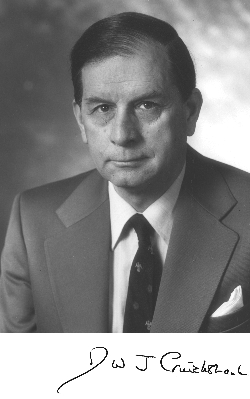Durward William John Cruickshank
Durward William John Cruickshank (7 March 1924 – 13 July 2007) was a British crystallographer known for his significant contributions to the field of X-ray crystallography. His work primarily focused on the development of methods for determining the atomic structure of crystals.
Early Life and Education[edit | edit source]
Durward Cruickshank was born in Stirling, Scotland. He attended Stirling High School before enrolling at the University of Glasgow, where he earned his BSc in Chemistry in 1944. He later completed his PhD in 1948 under the supervision of John Monteath Robertson, a pioneer in the field of crystallography.
Career[edit | edit source]
After completing his PhD, Cruickshank joined the University of Leeds as a lecturer in 1948. He later moved to the University of Manchester in 1954, where he spent the majority of his career. At Manchester, he was appointed as a Professor of Theoretical Chemistry in 1967 and later became the Head of the Department of Chemistry.
Cruickshank's research was instrumental in advancing the precision of X-ray crystallographic methods. He developed mathematical techniques to improve the accuracy of atomic position determination within crystals. His work laid the foundation for many modern crystallographic software programs used today.
Contributions to Crystallography[edit | edit source]
Cruickshank's contributions to crystallography are numerous. He is particularly known for his work on the refinement of crystal structures and the development of error analysis methods in crystallography. His research has had a lasting impact on the field, influencing both theoretical and applied aspects of crystallography.
Awards and Honors[edit | edit source]
Throughout his career, Cruickshank received numerous awards and honors. He was elected a Fellow of the Royal Society (FRS) in 1979, one of the highest honors a scientist in the UK can achieve. He was also a Fellow of the Royal Society of Edinburgh (FRSE) and received the Gregory Aminoff Prize from the Royal Swedish Academy of Sciences in 1982.
Personal Life[edit | edit source]
Cruickshank was married to Margaret Cruickshank, and they had two children. He was known for his dedication to teaching and mentoring young scientists, many of whom have gone on to have successful careers in crystallography and related fields.
Legacy[edit | edit source]
Durward Cruickshank's work continues to influence the field of crystallography. His methods and techniques are still in use today, and his contributions have paved the way for many advancements in the understanding of crystal structures.
Related Pages[edit | edit source]
- X-ray crystallography
- University of Glasgow
- University of Manchester
- Royal Society
- Gregory Aminoff Prize
References[edit | edit source]
External Links[edit | edit source]
Search WikiMD
Ad.Tired of being Overweight? Try W8MD's physician weight loss program.
Semaglutide (Ozempic / Wegovy and Tirzepatide (Mounjaro / Zepbound) available.
Advertise on WikiMD
|
WikiMD's Wellness Encyclopedia |
| Let Food Be Thy Medicine Medicine Thy Food - Hippocrates |
Translate this page: - East Asian
中文,
日本,
한국어,
South Asian
हिन्दी,
தமிழ்,
తెలుగు,
Urdu,
ಕನ್ನಡ,
Southeast Asian
Indonesian,
Vietnamese,
Thai,
မြန်မာဘာသာ,
বাংলা
European
español,
Deutsch,
français,
Greek,
português do Brasil,
polski,
română,
русский,
Nederlands,
norsk,
svenska,
suomi,
Italian
Middle Eastern & African
عربى,
Turkish,
Persian,
Hebrew,
Afrikaans,
isiZulu,
Kiswahili,
Other
Bulgarian,
Hungarian,
Czech,
Swedish,
മലയാളം,
मराठी,
ਪੰਜਾਬੀ,
ગુજરાતી,
Portuguese,
Ukrainian
Medical Disclaimer: WikiMD is not a substitute for professional medical advice. The information on WikiMD is provided as an information resource only, may be incorrect, outdated or misleading, and is not to be used or relied on for any diagnostic or treatment purposes. Please consult your health care provider before making any healthcare decisions or for guidance about a specific medical condition. WikiMD expressly disclaims responsibility, and shall have no liability, for any damages, loss, injury, or liability whatsoever suffered as a result of your reliance on the information contained in this site. By visiting this site you agree to the foregoing terms and conditions, which may from time to time be changed or supplemented by WikiMD. If you do not agree to the foregoing terms and conditions, you should not enter or use this site. See full disclaimer.
Credits:Most images are courtesy of Wikimedia commons, and templates Wikipedia, licensed under CC BY SA or similar.
Contributors: Prab R. Tumpati, MD

